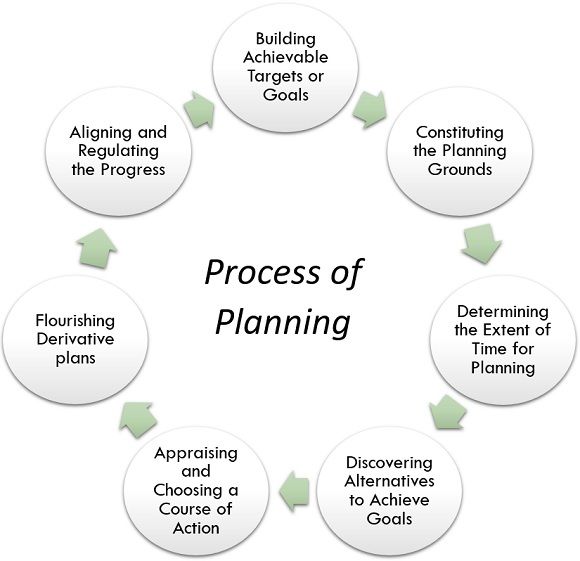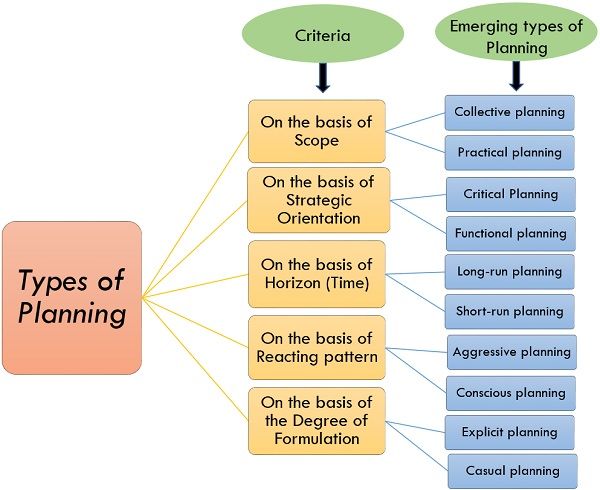Definition: Planning is a process of developing strategies for accomplishing the pre-determined goals of the company. It is an essential aspect of any business as planning a future adds value to the business. Planning focuses on both an individual or a group target. Efficient planning flourishes the business and encourages the personnel to work effectively on targeted objectives.
Content: Planning
Process of Planning
Planning is a method of determining future objectives and the ways to reach those objectives in an efficient manner. It helps in facing the obstacles that can come in the way while doing the business. This process may vary according to business type and structure. The following steps should be followed in the process of planning:

1. Building Achievable Targets or Goals
The foremost step of planning is to build the targets that have to be achieved, and such objectives are set-up by the company’s top-level personnel. Likewise, the manager may choose the desired volume of sales or the expansion of the services depending upon the primary sector of the company.
2. Constituting the Planning Grounds
Another step of planning is to constitute the grounds of the planning as it is done for the future, which is uncertain. Thus, the manager makes some assumptions in regards to the business prospect, and on that ground, planning gets executed. These assumptions act as a ground or basis for the planning process. It plays a vital role in business success as they flourish the relevant information revealing the future aspects. Such as trends going on in the market, economic conditions, competitors behaviour, cost of production, availability of material, government norms, etc.
3. Determining the Extent of Time for Planning
The third step after building targets and constituting planning grounds by the top-level management is to determine the extent of time for the planning. The course of businesses may vary accordingly. In some cases, plans are made for one year, while it may be made for decades for others. However, it is decided based on some logic; companies usually select their term on a future that can rationally be expected.
Other determinants which affect the course of time are as follows:
- Margin period in the evaluation and commercialization of the new product.
- Requisite time for capital investment recovery.
- Duration of already made commitments.
- Discovering Alternatives to Achieve Goals
Choosing the alternative options is the next step in the process of planning; usually, there are various options available to achieve the desired targets. For example, the company can launch advertising campaigns to raise its sales, reduce the prices to fascinate more customers, and achieve the desired targets, requiring imagination and foresight. Various critical elements should keep in mind while determining such alternative options.
4. Appraising and Choosing a Course of Action
After selecting a desired alternative option, the next action should be to assess these alternatives by keeping in mind the grounds and goals of the business. Then select the best alternative course of action, which can be calculated adjacent to the criteria of cost, benefits, risks and managerial facilities. The strength and weakness of every alternate course of action should be appropriately analyzed before selecting it, which becomes more accessible with the help of quantitative techniques and operations research.
5. Flourishing Derivative Plans
After getting the developed plans, extensive targets should be adopted in the daily operations of the business. The middle and lower-level personnel should make relevant plans, and budgets for their sub-units and such plans are known as Derivative Plans. For making such plans, the middle and lower-level personnel follow similar steps as taken by the top-level personnel. i.e., choosing realistic targets and evaluating the strength and weakness of their sub-units.
6. Aligning and Regulating the Progress
After doing all the planning, if we sit down without aligning the progress level, the plan can never be successful. Thus, regulating the plans plays a vital role in any planning process. Management needs to keep a regular eye on the plans progress so that they can take any required action at the time of need or can change the plan if it is not working.
Types of Planning
Planning has various distinct angles according to different approaches. Although all types of planning are interconnected and collective, their classification is not mutually exclusive. Planning can be classified based on the use of appropriate criteria or dimensions such as scope, strategic orientation, horizon, reacting patter and degree of the formulation. It can be further classified into five immense classes, as shown in the figure below:

- On the Basis of Scope
Based on the scope, the planning is divided into two parts. They are as follows:
- Collective planning: By covering the entire company’s matters, the top-level does the collective planning, i.e., it is common planning for all the departments of the company, which includes the objective setting, controlling and measuring the performance of the plan or improving personnel by way of decision-making. This planning is done with long-term objectives.
- Practical planning: This planning is also termed as departmental planning, which deals with primary functions of the company, such as production planning.
- On the Basis of Strategic Orientation
Based on Strategic Orientation, the planning is divided into two parts. They are as follows:
- Critical Planning: This planning is done on the basis of the strategic consideration for the long-run of time and covers all the major strategic or technical portion of the planning of the departments of the company.
- Functional planning: This planning is related to routine operation activities of the company. It is done in the short-term to carry out the functions, although it is prepared with strategic planning.
- On the Basis of Horizon (Time)
Based on Horizon, the planning is divided into two parts. They are as follows:
- Long-run planning: Planning done today having a long-term impact on the company’s future and decisions is known as long-run planning. Generally, it ranges from 4 to 5 years; however, it may range from 10 to 20 years. This planning covers all the functional areas of the company for which active participation of top-level managers are required. Elements like economic, technical and social are duly considered while preparing long-term plans such as future trends and expected outcomes.
- Short-run planning: This planning, by its name, explains that it is done for a short period of time. i.e., for 1 year or less than 1 year and is performed by the middle and lower-level managers of the company. It focuses on the day to day activities and supports in the application of long-run planning.
- On the Basis of Reacting pattern
Based on Reacting pattern, the planning is divided into two parts. They are as follows:
- Aggressive planning: This planning is done for facing the environmental changes before they took place; it formulates appropriate courses of actions for expected changes in the environment. A company needs to do a detailed scanning of the pertinent business environment and the prominent changes, which keeps the company ready to face changes, which keeps the company ready to face the changes effectively and to reduce the chances of adverse effects of such changes.
- Conscious planning: Conscious planning consists of a company’s plan after the environmental changes have appeared, such as the launching of a product after the competitors have already launched it. However, this planning has very limited scope change the situation in its favour.
- On the Basis of the Degree of Formulation
Based on the Degree of Formulation, the planning is divided into two parts. They are as follows:
- Explicit planning: The managers do this planning with all norms and procedure assigned by the company in a structured manner. It includes all the planning as mentioned above patterns such as long-term, short-term planning, as well as the company’s resource ability.
- Casual planning: Casual planning is not systematic analytical planning; it is done by the managers on the basis of their experience, knowledge and estimates. The planner of such planning becomes liable for the result of this planning. It is useful for small companies because the managers need not strictly follow the norms and procedures assigned by the company.
Conclusion
Planning is an integral function of any company’s managerial department. It is basically a process of deciding what is to be done and how it is to be done for the future course of action. It also acts as a core for selecting optimum alternatives.
Leave a Reply